

Guess That Color! — Ctrl+Paint - Digital Painting Simplified. The Dimensions of Colour. Figure 2.1.
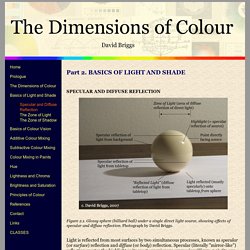
Glossy sphere (billiard ball) under a single direct light source, showing effects of specular and diffuse reflection. Photograph by David Briggs. Light is reflected from most surfaces by two simultaneous processes, known as specular (or surface) reflection and diffuse (or body) reflection. Specular (literally "mirror-like") reflection creates the highlight as its most conspicuous expression (Figure 2.1). On our ball, as on most substances apart from the coloured metals like copper and gold, the specular reflection retains the colour of the (white) light source.
In specular reflection, light bounces according to the rule that the angle of incidence (measured against a line perpendicular to the surface) equals the angle of reflection. Itchy animation - quirky illustration and characters by Richard Yot. LIGHT - a detailed tutorial Throughout this article I will be using a diagram of a white ball on white card to demonstrate how light behaves in different everyday situations: Here it illustrates a sunny afternoon.
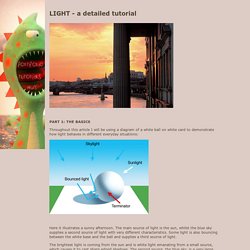
The main source of light is the sun, whilst the blue sky supplies a second source of light with very different characteristics. Some light is also bouncing between the white base and the ball and supplies a third source of light. The brightest light is coming from the sun and is white light emanating from a small source, which causes it to cast sharp edged shadows. The light coming from the blue sky has a very strong colour cast which affects everything in this scene. ArtSchool Online: Digital Art: Photoshop Painting: The Suit. Color theory.
Vision and color are at the heart of painting.
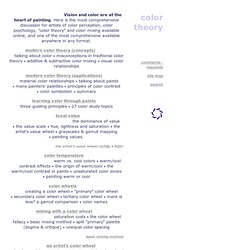
Here is the most comprehensive discussion for artists of color perception, color psychology, "color theory" and color mixing available online, and one of the most comprehensive available anywhere in any format. modern color theory (concepts) talking about color • misconceptions in tradtional color theory • additive & subtractive color mixing • visual color relationships modern color theory (applications) material color relationships • talking about paints • many painters' palettes • principles of color contrast • color symbolism • summary learning color through paints three guiding principles • 27 color study topics tonal value the dominance of value • the value scale • hue, lightness and saturation • the artist's value wheel • grayscales & gamut mapping • painting values. the artist's value wheel (HTML • PDF)
PSG Art tutorial. Foreword I believe there is logic behind why a picture works or not.
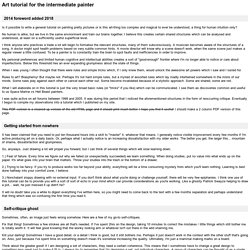
I also believe that humans are meat machines, and that one day computers will be able to emulate humans and what we do. Since logic can be formulated into rules, guidelines and theories, these can be shared. I will attempt to do so here. Note that I have just empirically deduced the theories I present here, and that I'm a highly fallible meat machine. Many rules also play against each other and may cancel each other out, or become invalidated because of a stylistic approach . The far most useful critique I can give developing artist is: Practice. Updates 2012 May02: Clarified stuff in the Terminology section.
Table of contents Licence This tutorial is, in its current form, free to translate and 'mirror' in that form. Because I may be updating it and new versions are generally better, I'd rather not have it mirrored too much. I guess this licence comes pretty close: Drawing1. I know you are all looking at this image and wondering, uh you lost it or something?
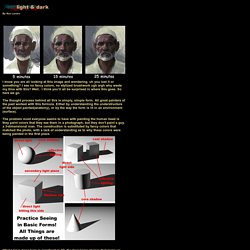
I see no fancy colors, no stylized brushwork ugh argh why waste my time with this? Well, I think you’ll all be surprised in where this goes. So here we go. The thought process behind all this is simply, simple form. All great painters of the past worked with this formula. The problem most everyone seems to have with painting the human head is they paint colors that they see them in a photograph, but they don't paint a guy, a 3-dimensional man. What I have done here is construct in 3D, the four basic shapes that make up just about anything the artist is going to draw or paint, the cone, sphere, cube and cylinder.
If you look at all these objects in the photos, they are 3d objects photographed 2 dimensionally, i.e. a flat picture plane. Moving onto our shapes; the sphere, cone and cylinder are all rounded in form. The biggest problem most people have is that they don’t paint in light and dark. Ron Lemen.